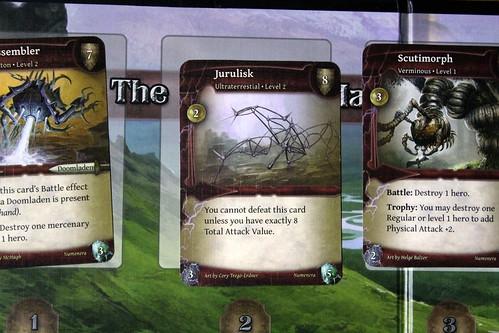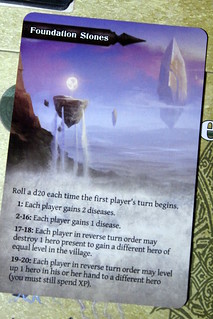| Strategy | Luck |
|---|---|
| Interaction | Components & Design |
| Complexity | Score |
What is different about Thunderstone Advance: Numenera then? The one big thing that sets this box apart from all other Thunderstone boxes is that it’s not set in a classic, Dungeons & Dragons inspired fantasy world. This box is set in the Ninth World of Monte Cook’s role-playing game Numenera. The Ninth World is not your typical fantasy world, being completely devoid of magic. But it has its own brand of mysterious, fantastic artifacts to make up for that, because the current inhabitants are not the first on this world. There were other civilizations there before, technologically infinitely more advanced, right up to the day they disappeared, followed by the next, who reached even greater heights, and also vanished without a trace. And so on. Only none of the old ones really vanished entirely without a trace, their artifacts, miracles of advanced technologies, can still be found all over the world. From harmless toys to terrible weapons, floating palaces to nanobot diseases that reshape every living thing they touch. That is the miraculous legacy of the precursors, and while it’s not strictly speaking magic, you have the same hopes of understanding it. If anything, these left behind technologies may be more terrifying than demons and dragons.

With the new setting comes, of course, a completely new set of cards. If there were no new cards, what would be the point of another Thunderstone box? The only familiar cards are your Adventuring Starter Kit with your familiar, faithful Regulars wielding Longspears, Torches and Thunderstone Shards. Beyond that, everything is very Ninth World. That is especially true for the monsters, the world of Numenera is inhabited by creatures far more terrible than Orcs or Owlbears. Just look at a Jurulisk and tell me you want to meet that thing even on a bright day. The different types of monsters have different themes to their abilities, making games very different from one another depending on which monsters are present. The Ultraterrestrials, for instance, put an upper limit on the Attack Value you may have in order to defeat them. But you must still overcome their health, that leaves you with a very narrow range of attack values that are useful to attack them and forces you to overthink the usual tactics of “a lot helps a lot”. The Ancient Ones interact with Light in different ways, the especially ugly Monstrosities destroy your cards – often one in Battle and one in the Aftermath – and there are more types of creatures still. Fortunately for you, you may also find Treasures with the monsters, cards that have especially potent effects once you loot them. Unfortunately, and unlike any other fantasy game I ever played, the monsters benefit from these items, too. You don’t know what fun is until you encounter a Cragworm with a Cellular Disruptor and destroy two heroes plus three other cards in Battle, and then one more hero in the Aftermath. Good Times!

But the new heroes are no slackers, either. Their names take some getting used to as they are all named after their most important attribute. So you might be headed into the dungeon with Clever, Tough and Stealthy. But at least that way you have a pretty good idea what you’re hiring. They bring a nice selection of abilities to the table, but standing out from the crowd are Swift and Rugged. Both have an ability that mark a monster in the hallway and another ability that you can use when that monster gets attacked, provided you have the right hero in your hand at the time. Rugged is the more benign of the pair, he lets you take an XP token when your marked monster is attacked or, at higher levels, lets you take a Prepare action out of turn – that’s the one where you discard some unwanted cards and refill your hand. That’s a pretty big thing. Swift is more offensive, when his marked monster is attacked you can add up to three health to it. I really like those two heroes, they add a bit of interaction to a game that mostly isolates players from each other – one of my biggest complaints about Thunderstone: Starter Set. And said interaction goes beyond forcing others to discard, too.
The village cards come with interesting effects as well. There are a few regular, old +x Physical Attack weapons, but most have interesting effects beyond simple numeric bonuses. My favorites here are the Warder and the Unstable Crystal. The former lets you look at the top card from any deck, even another player’s, and put it on the bottom if you wish. Another fun and evil way to interact. The Unstable Crystal is +3 boost to magic attack that doubles as a light source. Pretty neat. And every time you use it, you add another copy of it to your deck as well. Awesome, right? Not so much, because if you ever have three or more present at a time, they blow up, end your turn and destroy themselves and another random card. It’s nice to see new card abilities without any added rules complexity.

So much for the new cards, but there are a few completely new things in the box as well. One are the differently colored experience tokens called Cyphers. Whenever you gain XP, you draw these tokens from a bag. You can use them to level your heroes, just like regular, old XP tokens. But you can also use them for special effects, depending on the color, a blue one to draw a card, an orange one to gain two gold and so on. Another very nice addition to the game, you finally have something to do with XP near the end of the game, and you have to make the tough decision sometimes if you want to spend a Cypher for its bonus instead of levelling a hero. The other new thing are Setting cards, oversized cards representing a Numeneran locale where the game takes place. They all have a trigger that makes a player roll the included 20-sided die and then apply the effect for that number. Those effects can be helpful, like merely discarding cards that would otherwise be destroyed by a monster, but some are pretty nasty as well. Most of the settings add a fun element to the game because good and bad effects are in balance and you have some control over when an effect applies. The exception is the Foundation Stones setting. That one should never be played and should, in all honesty, never have been made. The combination of trigger – every time it’s the first players turn – and most common effect – draw disease cards – leads to the second player always gaining an indecent amount of diseases, with no real chance to get rid of them (click the phototo the left for details). Just do yourself a favor, put that one card at the bottom of the box and forget it exists.

That one blunder aside, Numenera is my favorite incarnation of Thunderstone out of the ones I tried. The cards are interesting and make players interact without creating discard orgies, all the Settings – because, remember, Foundation Stones does not exist! – create a different flavor and the Cyphers add interesting decisions. The card illustrations are top-notch, especially the monsters have some wonderfully creepy ones. Theoretically, you can mix Numenera with other Thunderstone sets, but wether or not you like the resulting Ninth World / D&D schizo-setting is a matter of taste. But this box can stand on its own.











